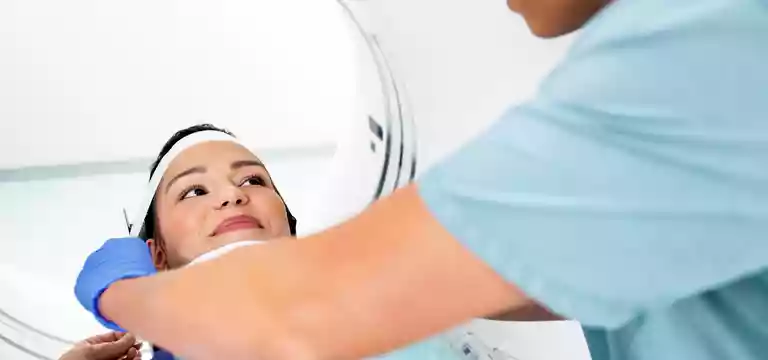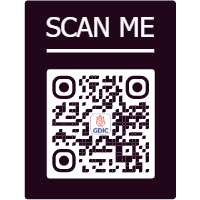
PET (Positron Emission Tomography) scans have revolutionized medical imaging, allowing doctors to visualize and diagnose a wide range of conditions. These scans utilize radioactive tracers to detect changes in cellular...
PET (Positron Emission Tomography) scans have revolutionized medical imaging, allowing doctors to visualize and diagnose a wide range of conditions. These scans utilize radioactive tracers to detect changes in cellular activity, providing valuable insights into the functioning of organs and tissues. However, it is essential to prioritize radiation safety during PET scans to minimize potential risks to patients and healthcare professionals.
At Ganesh Diagnostics, we understand the significance of radiation safety and are committed to ensuring the highest standards of patient care. In this comprehensive article, we will delve into the world of PET scans, explore the risks associated with radiation exposure, discuss precautions to enhance safety, highlight the role of regulatory bodies, and ultimately explain why Ganesh Diagnostics is the best diagnostic center for PET scans.
Explaining PET Scans and Their Purpose
PET scans utilize a combination of radioactive tracers and advanced imaging technology to create detailed three-dimensional images of the body's internal structures. These scans are particularly effective in detecting changes at the cellular level, enabling early diagnosis and monitoring of various conditions such as cancer, heart disease, and neurological disorders.
Brief Overview of Radioactive Tracers Used
Radioactive tracers, also known as radiopharmaceuticals, are essential components of PET scans. These tracers are substances that emit positrons, which are positively charged particles. When injected into the body, the radiopharmaceuticals accumulate in specific organs or tissues and emit signals that are detected by the PET scanner, producing images that reveal abnormalities or areas of interest.
Radiation Exposure in PET Scans
Types of Radiation Emitted
PET scans involve the emission of ionizing radiation, which consists of high-energy particles or electromagnetic waves that can cause ionization or the removal of electrons from atoms. The radioactive tracers used in PET emit positrons, which annihilate electrons upon collision, releasing energy in the form of gamma rays.
Measurement of Radiation Dose
The amount of radiation received during a PET scan is measured in units called sieverts (Sv) or millisieverts (mSv). The effective dose provides an estimate of the potential biological effects of radiation on the body. PET scans typically involve low to moderate radiation doses, ranging from 2 to 10 mSv, depending on various factors such as the type of radiopharmaceutical used and the duration of the scan.
Comparison with Other Imaging Modalities
When compared to other imaging modalities, such as CT (computed tomography) scans or nuclear medicine scans, PET scans generally result in higher radiation doses. However, it is crucial to note that the benefits of the information obtained from PET scans often outweigh the associated risks, especially when performed by experienced professionals and with proper radiation safety measures in place.
Potential Risks Associated with Radiation Exposure in PET Scans
Acute Effects of Radiation
The immediate effects of radiation exposure during a PET scan are minimal. Patients may experience mild discomfort at the injection site or encounter allergic reactions to the radiopharmaceutical. However, the radioactive tracers used in PET scans have short half-lives, meaning they quickly lose their radioactivity, minimizing the risk of acute radiation effects.
Long-Term Risks and Potential Damage
While the risk of immediate harm from PET scans is low, long-term risks associated with radiation exposure exist. Prolonged exposure to ionizing radiation may increase the likelihood of developing certain types of cancer or other radiation-related complications. However, it is important to note that the radiation doses used in PET scans are carefully controlled and typically fall within acceptable limits.
Factors Influencing Radiation Risks
Age and Gender
Younger individuals and children are generally more sensitive to radiation due to their developing tissues. Females also have a slightly higher susceptibility to radiation-induced cancers than males.
Cumulative Radiation Exposure
Accumulated exposure to radiation from various sources, including previous imaging scans or occupational exposure, may increase the overall risk associated with PET scans. It is crucial for healthcare providers to consider the cumulative radiation dose and determine the appropriateness of each scan.
Radiosensitivity of Tissues
Different tissues and organs in the body exhibit varying levels of radiosensitivity. For instance, rapidly dividing cells, such as those in the bone marrow or reproductive organs, are more susceptible to radiation damage. The potential risks associated with PET scans must be carefully assessed on an individual basis.
Precautions to Ensure Radiation Safety in PET Scans
Qualified Personnel and Equipment
PET scans should only be performed by qualified healthcare professionals who are trained in radiation safety protocols and possess expertise in operating PET scanners. At Ganesh Diagnostics, we take pride in our team of highly trained and experienced staff who prioritize patient safety and provide comprehensive care.
Optimizing Scan Protocols
To ensure radiation safety, scan protocols must be optimized based on the specific diagnostic requirements of each patient. By tailoring the scan parameters, such as the radiopharmaceutical dose and duration of the scan, radiation exposure can be minimized while maintaining image quality.
Minimizing Radiation Exposure
Shielding and Protective Measures
During PET scans, patients may be required to wear lead aprons or other shielding devices to minimize radiation exposure to areas of the body not under investigation. Additionally, healthcare professionals should adhere to strict radiation safety practices, such as wearing appropriate protective gear and maintaining a safe distance from the scanner.
Timing and Duration of Scans
Careful consideration of the timing and duration of PET scans is essential to optimize radiation exposure. Minimizing the time spent in close proximity to the radiopharmaceutical allows for a lower radiation dose while still obtaining the necessary diagnostic information.
Radiation Dose Reduction Techniques
Advancements in technology and imaging protocols have enabled the development of dose-reduction techniques for PET scans. These techniques, such as iterative reconstruction algorithms and time-of-flight PET, improve image quality while reducing the radiation dose received by the patient.
Patient Education and Informed Consent
At Ganesh Diagnostics, we prioritize patient education and ensure that individuals undergoing PET scans are fully informed about the procedure, its potential risks, and the necessary precautions in place to ensure radiation safety. Informed consent is obtained, allowing patients to make informed decisions about their health.
Regular Monitoring and Quality Assurance
To maintain radiation safety standards, regular monitoring and quality assurance programs are essential. Ganesh Diagnostics follows stringent quality control measures to ensure the accuracy and reliability of PET scan results while minimizing radiation risks.
The Role of Regulatory Bodies in Ensuring Radiation Safety
Overview of Regulatory Organizations and Guidelines
Various national and international regulatory bodies, such as the Atomic Energy Regulatory Board (AERB) in India and the International Atomic Energy Agency (IAEA), have established guidelines and regulations to ensure radiation safety in medical imaging procedures. These organizations provide standards for equipment calibration, personnel training, and quality assurance to safeguard patients and healthcare professionals.
Accreditation and Certification of PET Facilities
To ensure the highest standards of radiation safety, PET facilities can undergo accreditation and certification processes. These processes involve rigorous evaluations of equipment, protocols, and adherence to radiation safety guidelines. Ganesh Diagnostics is proud to be an accredited and certified diagnostic center for PET scans, demonstrating our commitment to excellence and patient safety.
Why Ganesh Diagnostics is the Best Diagnostic Center for PET Scans
Ganesh Diagnostics is a renowned diagnostic center in India, offering a wide range of advanced imaging services, including PET scans. With our state-of-the-art facilities, expert team, and commitment to radiation safety, we provide patients with accurate diagnoses and personalized care.
Key Features and USPs
Highly Trained and Experienced Staff
At Ganesh Diagnostics, our team consists of skilled radiologists, nuclear medicine specialists, and technologists who possess extensive experience in performing PET scans. Their expertise ensures the highest quality imaging and patient safety.
State-of-the-Art Equipment and Technology
We pride ourselves on utilizing cutting-edge PET scanners and advanced imaging technology to deliver accurate and detailed diagnostic information. Our equipment undergoes regular maintenance and calibration to ensure optimal performance and radiation safety.
Commitment to Radiation Safety
Radiation safety is our top priority at Ganesh Diagnostics. We strictly adhere to international guidelines and best practices, implementing comprehensive radiation safety protocols to minimize patient and staff exposure.
Wide Availability with Branches in 7 Areas across Delhi
To provide convenience to our patients, Ganesh Diagnostics has established branches in 7 prominent areas across Delhi, including Rohini, Hari Nagar, Firozabad, Mangolpuri, Model Town, Nangloi, and Yamuna Vihar. Our easily accessible locations make it convenient for patients to undergo PET scans with us.
Multiple Panels Availability for Comprehensive Diagnostics
In addition to PET scans, Ganesh Diagnostics offers a wide range of diagnostic panels, allowing for comprehensive evaluation of various health conditions. Our panels encompass different imaging modalities, laboratory tests, and specialized examinations to meet diverse patient needs.
Conclusion
In conclusion, ensuring radiation safety in PET scans is crucial to minimize potential risks while harnessing the benefits of this powerful imaging technique. Understanding the risks associated with radiation exposure, implementing essential precautions, and choosing a reputable diagnostic center like Ganesh Diagnostics are vital steps in prioritizing patient well-being.
At Ganesh Diagnostics, we are committed to providing the highest standard of care, incorporating radiation safety protocols, and delivering accurate diagnostic information. Contact us today to schedule your PET scan and experience our exceptional services.
FAQs
How does Ganesh Diagnostics ensure radiation safety in PET scans?
Ganesh Diagnostics prioritizes radiation safety through qualified staff, state-of-the-art equipment, optimized protocols, and strict adherence to radiation safety guidelines. Our commitment to patient well-being is unwavering.
Are PET scans safe for children and pregnant women?
PET scans involve exposure to ionizing radiation, and special precautions are necessary for children and pregnant women. Our experienced team assesses the risks and benefits on an individual basis to ensure safety and accurate diagnoses.
How can radiation exposure during PET scans be minimized?
Ganesh Diagnostics implements various strategies to minimize radiation exposure during PET scans, including shielding and protective measures, optimized scan protocols, and radiation dose reduction techniques.
What are the potential risks of radiation exposure in PET scans?
While the risk of immediate harm from PET scans is low, long-term risks include an increased probability of developing certain types of cancer or radiation-related complications. However, the radiation doses used in PET scans are carefully controlled to fall within acceptable limits.
What should I expect during a PET scan at Ganesh Diagnostics?
At Ganesh Diagnostics, you can expect a comprehensive and patient-centric approach. Our expert team will guide you throughout the process, explaining the procedure, addressing any concerns, and prioritizing your comfort and safety.









